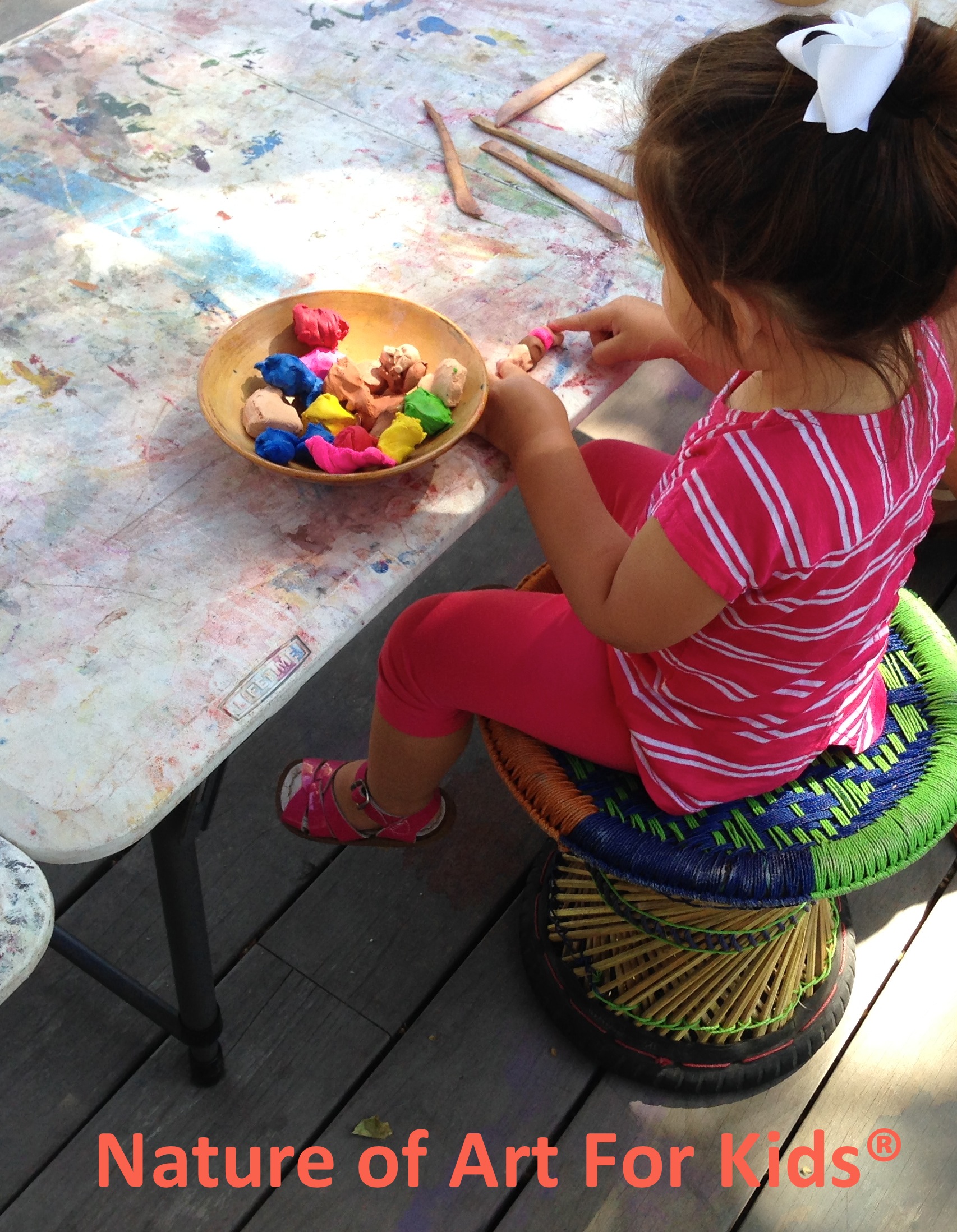
How Clay Relieves Stress
Many kids today suffer from stress and anxiety. Therefore, today I would like to suggest playing with clay as an alternative to relieve stress. Scheduling time to play with clay at least once a week can lead to beneficial stress relief. As a parent or caregiver, you can provide many other helpful aids in managing stress, such as better nutrition, adequate sleep, fewer anxiety-provoking situations, positive reassuring words, and more simple time to relax and just be a kid.
In my art classes I’ve witnessed positive results from children exploring clay in a playful manner, which always leads to relaxation. Most of my art activities, like clay play, are multi-sensory and engaging, helping children relax and play calmly. It’s common knowledge that unstructured simple play is healthy for young children’s development.

Why Clay Play is Calming
Touching clay induces stimulating neural input from most of our sensory senses. When a young child starts touching, forming, or modeling it, it’s considered active learning. Playing with clay stimulates tactile input, visual pathways communicate with both the left and right hemispheres of the brain, and auditory and olfactory sensory systems are also collecting information.

Playing with clay is a high visual-auditory connectivity in the brain. Strong connectivity occurs and the child becomes intensely focused on his hand work. Children using their hands can be so engaged that other stress related thoughts clear their minds.
Clay Play Fires Neurons
The electrical activity stimulated in the brain becomes a different type of action firing connections allowing children to focus on their hand work only. A calming effect takes place because cognitive processing is occurring while forming or manipulating clay. It’s good for children during their sensitive periods to develop good habits and activities that can help early in life to regulate relaxation by creative hand work.

Types of Cays
Many types of clay are available for this type of exploring. Only use non-toxic child grade products. You can use any type of clay, in fact you should allow children to try all different types of clay at some point in time. You can also make quick easy modeling dough from simple kitchen ingredients.
Clay can be non-hardening, air-hardening or baked to harden. Natural modeling beeswax can also be used for clay play forming. You can order these types of clay online or find them in most craft and art supply store.
- Beeswax
- Non-hardening clay (plastiline)
- Air dry
- Pottery clay
- Homemade modeling play dough

What can children make with clay?
To promote relaxation, you should allow the child to explore their handiwork with minimal instruction. Keep this time relaxing and child-led in creating. Simple projects can be guided by making forms like rolling a ball or shaping snake coils as a starting point. Here are some fun ideas:
- Animals like birds, snakes, worms, dogs, cats, fish
- Nature: flowers, leaves, trees
- Fruits: apples, banana, strawberry, orange
- Cartoon characters
- Use cookie cutter shapes for ease
- Process-based work: playing with rollers, cookie cutters, or clay modeling tools
Order “Clay Play,” a new book by Spramani Elaun, for clay playing ideas and a materials list.

BUY CLAY PLAY BOOK

BUY CLAY MODELING CURRICULUM


All rights reserved © 2025, Nature of Art®

No part of this blog may be used or be reproduced in any manner whatsoever including reproducing, publishing, performing, and making any adaptions of the work – including translation into another foreign language without written permission except in the case of brief quotations embodied in critical articles and reviews. Nature of Art® Publishing P.O. Box 443 Solana Beach, California 92075.



Recent Comments
[…] Read how clay can relieve stress for kids here! […]
[…] Learn how playing with clay can relieve stress click here! […]
http://October%20|%20Art%20Teacher%20|Project%20|%20Blog
October 6, 2015 at 12:56 am[…] I shared my views how clay can relieve stress for kids PLAYING WITH CLAY. […]
[…] Read other articles by Spramani: Learn how playing with clay can relieve stress click here! […]
Comments are closed.